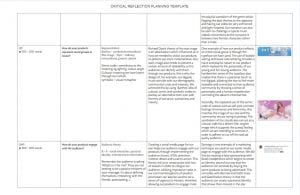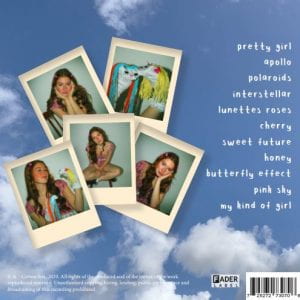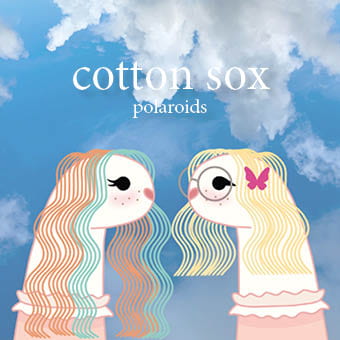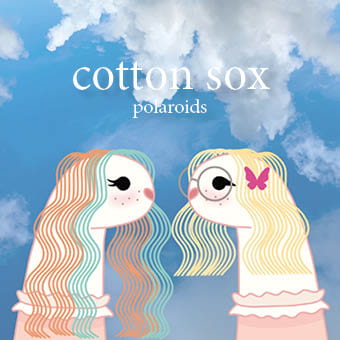Critical Reflection Essay
Sylvie Rouget
A promotion package for the release of an album, to include:
- a music video (major task)
- a social media page (minor task)
- a digipak (minor task)
- How do the elements of your production work together to create a sense of ‘branding’?
- How did your research inform your products and the way they use or challenge conventions?
- How do your products represent social groups or issues?
- How do your products engage with the audience?
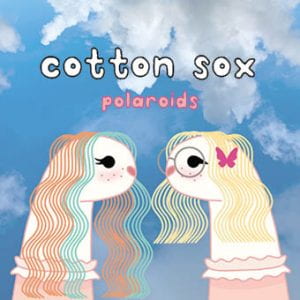
Front of the finished digipak
Stuart Hall’s reception theory shows us how our brand needs to have a cohesive message across all products which can be used to encode specific messages (ideologies) for the audience to decode in order to achieve a preferred reading of the text. It is important for our brand’s messages of youth, playfulness and creativity to come across effectively so that the audience will receive the right message and buy into the brand and it’s products.
Our products worked together to create a sense of branding by all having the same repeating visual motifs throughout. These motifs include the bubble-writing typeface, the sock puppets and also the imagery of a summery, soft-hued sky. All of these motifs are

Tour promotion on social media page
represented in each of our products; for example, the sock puppets used in the music video were digitally recreated for the digipak and the design features of the digipak were carried through to promotional posts on our social media. These repeating components encode our products’ brand as child-like from the sock puppets but also with an unusual, magical element from the use of the different coloured clouds/sky.
The similar design features of each of our products create a cohesive brand by giving it a recognizable colour palette and style which becomes synonymous with the star’s brand. This helps our products become more of a lifestyle and brand that the audience may find engaging rather than just a set of separate pieces; allowing a certain demographic to identify with it as their preferred reading material. The demographic our brand aims at is

Screenshot from narrative element of the music video
alternative teenage girls to young adults which our brand appeals to through the use of the soft ‘girly’ colours,also notably the unusual metaphor of the sock puppets which is not a prop conventionally used to represent an artist, showing the slightly alternative and quirky route our brand takes.
According to Nick Lacey, a piece of media has a ‘repertoire of elements’, these elements are what makes our product conventional to its’ indie-pop genre through the use of sound, costume, setting, theme and camera/editing amongst other components. Richard Altman suggests that these main components define a blueprint for the product, in our case a music video, and can be either followed to adhere to our indie-pop genre or be challenged to evolve the genre to something more. We chose to do both by keeping some typical conventions we’d noticed in professional videos in order to make sure that it is still clearly in our chosen genre; however we also subverted some conventions so as to bring something new and evolve the genre.

Screenshot of performance piece of the music video
One example of our research reflecting our production is through analysing the music video ‘Mariposa’ by Peach Tree Rascals, a music video of the same indie-pop genre of our music video. This analysis shows that a convention for a video of this genre is being outdoors/in a summery setting. We mirrored this in our music video by the majority of our shots being outside in a rural setting using a naturalistic high key colour palette. This is a convention in the indie genre because it connotes the laid-back, playful and fresh feel of the music.
A second example of how our research influenced our final product was through looking at other more indie/alternative female artists to see how their music videos are designed and

Screenshot from performance element of the music video
shot. One very prevalent alternative artist is Billie Eilish, whose music videos are conventionally very surreal and usually have darker themes and clashing colours. We challenged this convention by keeping the playful surrealism of the genre whilst flipping the dark themes to the opposite and having our video be very soft toned and light-hearted to appeal to a more optimistic and playful audience. Our narrative can also be seen to challenge a typical music video’s conventions as the romance is between two female characters rather than a male.
Richard Dyer’s theory of the star image is an observation which influenced us in how we needed to utilise our products to present our star’s metanarrative. Our star’s image also needs to present a certain amount of relatability so the audience can identify with them through our products, this is why the design of, for example, our digipak, must coincide with our demographic community’s style and interests. We achieved this by Barthes’ idea of cultural, semic and symbolic codes portraying an alternative teen icon with themes of romance, surrealness and naivety.

Typeface used for front of digipak
One example of how our product reflects an entire social group is through the typeface we have used. The use of bubble writing and lower case lettering encodes a naive and playful nature to our product which represents the personality of our young and fun-loving audience. The handwritten sense of the typeface also implies that there is a personal touch to the digipak, allowing the star to feel more relatable and connected to their audience community by showing a sense of personality and a human authenticity connoting the album’s informal feel.
Secondly, the repeated use of the semic code of colours such as soft pink connote feelings of romance and femininity,
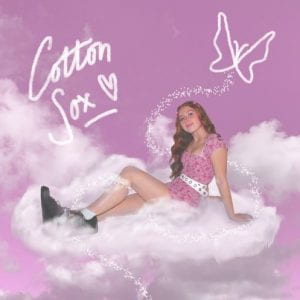
Inside leaf of digipak
this matches the image of our star and the community we are trying to portray. The symbolism of the clouds also can act as a cultural code for a dream-like, angelic image which supports the surreal feeling which we are intending to connote in order to adhere to our off the wall and quirky audience.
Creating a social media page for our star helps our audience engage with our products through implementing the audience theory, AIDA: attention, interest, desire and a call to action. This theory led us to create posts with lots of teasers in order to intrigue our audience. Utilising imperative verbs as a call to action in our comments/captions of product promotion can also be used to stir a sense of urgency to interact; therefore allowing our products to engage more heavily with our audience.

Caption of social media post
Synergy is one example of a marketing technique we used on our social media page to engage with the audience. We did this by creating a sponsorship with Beats headphones which begins to create an identity around our star of a fidelity to music that the audience can recreate by buying the same products as being advertised. This coincides with Blumler and Katz’s Uses and Gratification theory in that the audience can create a personal identity that shows their interest in the star through copying and buying into what we advertise on the social media page.
Secondly, another post on our social media page which allows our audience to engage and interact with our artist is

Competition post on social media page
the “competition” we set up. This post was a call to action for the audience to share the post to win a prop used in the star’s music video, an example of using cross media convergence as a marketing element. By doing so we are utilising Blumler and Katz theory by giving the audience a platform for social interaction and thus advertising our star by the internet’s word of mouth. This competition would also help to form the audience’s personal identity around the star because they would feel connected to them through owning the same prop that the star used and maybe even making their own videos with it. This creates a sense of community around the star and allows the audience to interact and therefore engage with the product.
Critical Reflection Prep
To prepare to write my critical reflection essay I put all of my ideas for each section into a planning document which made sure my essay would be structured correctly. I used this plan to construct each section of my essay which could then be put together to make the final piece. This preparation made it easy for me to make sure I was answering the questions, using theory and also using examples of my own work.
Please click on the JPEGs below to view the full planning document:
Timeline and Marketing Ideas
Below is a list in chronological order of what our social media timeline will consist of:
- Album polaroid camera teaser
- Livestream announcement
- Music video teaser
- Music video release
- Competition
- Behind the scenes
- Tour announcement
- Album announcement banner
We aim to structure our page to all lead up to the release of our star’s debut album; we will achieve a sense of anticipation and build up by giving small teasers and sneak peaks to the followers leading up to the release. This keeps the importance of the album release as the top priority of the star and therefore their fans. Another component that is important to our star’s page is audience interaction. We will show this by advertising live streams for the star to speak to her audience and also by a competition based on fans liking and sharing the star’s posts in order to win her most famous props, the sock puppets seen in her music video and album.
Audience interaction with a social media page- analysis
The screencastify below presents Tessa Violet’s Facebook page and how she uses it to intrigue and interact with her audience:
Social Media Page Terminology
To see what key conventions artists use on their social media we analysed the Facebook page of female indie artist Tessa Violet. We chose to analyse this artist in particular because she has a very similar demographic and image to our star so what she posts should be similar to our social media page.
This activity showed us how stars act on the internet and how they use these sites to promote their music and connect with their fans through posts, live videos and other mediums.
Digipak Draft 3
To make sure that the third draft of our digipak could be our final draft we sent out a poll to our peers asking them to choose which genre they would think our digipak represents. The majority of the responses selected the correct genre, which was indie, however a small amount chose pop which is still useful to know since we would class the genre as indie-pop more specifically.
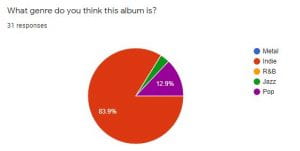
These are the final images for the final draft, please click on the images to view the full PDF:
Digipak draft 2
For our second draft we’ve added our design elements to the inside covers and added the typical conventions of a digipak such as copyright information and a record label.
Below is a Screencastify of our teacher giving us feedback:
Targets for improvement:
- Change the typeface to a sans serif font and try to make it pop out from the background more.
- Add more illustrations to tie in the butterfly on the inside cover
- Remove the logo from the socks
- Colour correct the polaroid images on the back cover
Digipak Draft 1
Please click on the image below to view the first full draft of our digipak. We have created our overall foundations of our digipak however we still need to add in crucial information such as the copywright and record label. Our inner panes also need the design elements added as at the moment this draft just shows their backgrounds whereas the designs of the outer panes are almost finished. We chose to use a digital drawing for our cover because it fits in well with the conventions of an indie genre digipak and also relates to the playful and youthful aspects of our artist. For the back cover we chose to use polaroid images to reflect the album’s title and also a lyric in our music video. One other component that is yet to be added is our typefaces as we have made them ourselves and have yet to upload them into indesign.
Evaluation of Shoot
Overall, our digipak shoot ran smoothly and we were able to get all of the shots that we envisioned in the drawn mock up and some other ideas we had too. We also shot with two different types of mise-en-scene because we were unsure of which one we preferred and fortunately we had enough time to do this. Another goal we intended to achieve from this shoot was to take some ‘behind the scenes’ images that we may use on our artists website to advertise the upcoming release of the album.
After looking at the contact sheets we were pleased that we completed everything we wanted to in the shoot and were able to choose which mise-en-scene we wanted for the final digipak. From reviewing the images we saw that we got the right poses we wanted to imply a casual/photo booth-esque feel to the back cover. One thing that needs to be changed is the lighting to look more like a disposable or polaroid camera has taken the pictures however this can easily be changed in PhotoShop later on.

